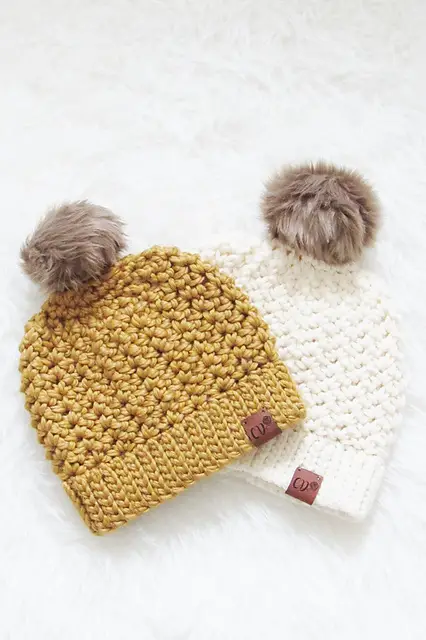This yarn weight is not just bulky, it is super bulky. Wonder how the Craft Yarn Council came up with that one?
Super bulky weight yarn is thicker than bulky weight, but thinner than jumbo weight (the thickest yarn yet). The fabric is thick and warm. It makes great chunky garments, accessories and blankets.
I know how difficult it can be to choose yarn when you are starting out. You just want to buy any skein that looks appealing and feels soft. But the yarn weight matters when you want a certain look to your project.
Just check out the top photographs. The scarf and the hats wouldn’t have that, thick warm fabric made from a different material. If you want to snag the free patterns, click the links to the designers blogs: Mo Simple Scarf by Churchmouse Yarns and Teas and 1.5 Hour Chunky Beanie by Crochet Dreamz.
In my previous articles we learned about Lace Weight, Super Fine, Fine Weight, Light/DK Weight, Medium/Worsted Weight and Bulky Weight yarn. In this one, I want to cover super bulky weight yarn and explain what the industry means by the term. Let’s get to it!
Super Bulky Weight Yarn Standards
The Craft Yarn Council (CYC) created a standard yarn weight system for the US. It is based on a number system that starts from 0, the thinnest, and goes up to 7, the thickest. Super bulky weight yarn is what the CYC considers a 6. Besides the numbering system, the CYC also gives guidelines for gauge and hook/needle sizes for super bulky weight yarn.
CYC Gauge and Tool Recommendations
Gauge, hook and needle suggestions for knit and crochet are printed on the labels. These are based on the testing done by the yarn manufacturers.
But the CYC put a set of guidelines for everyone (in the US) to use, which is listed below. The information is based off of the CYC website and you can access that here for more details.
| Standard CYC Gauge* | Recommended Tool Size | |
| Knit | 7 – 11 sts stockinette | 8 – 12.75mm , 11 – 17(US) needles |
| Crochet | 7 – 9 sts sc | 9 – 15 mm , M-13 – Q (US) hook |
Ravelry (an online database for crochet and knitting patterns) also provides a guideline for knit gauge. According to them, you should get 5-6 stitches per 4 inches (10 cm). You can see that this is in align with what the CYC says.
Remember though, these are not exact. The gauge and hook/needle size provide you with a strong baseline, but you should always do your own testing.
Wraps Per Inch
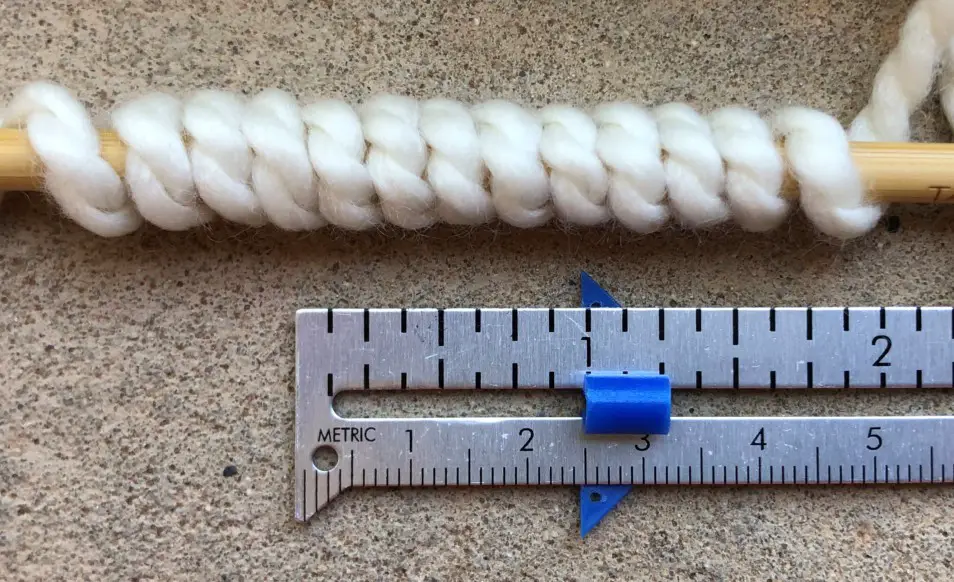
Wraps per inch (WPI) is useful for yarn weights if you ever lose your labels. Measuring WPI is super simple. The CYC has more detailed information on their website here. But basically you wrap yarn around a pencil. Then you measure an inch and count how many wraps are in that inch. Finally, you compare to the CYC standards for WPI to know what the yarn weight is.
The CYC states that super bulky weight (6) should have 5-6 wraps per inch. Unfortunately, at this time I don’t have any super bulky weight yarn on hand to compare my numbers to, so I used other reputable sources, Bluprint and Ravelry.
Bluprint says that super bulky weight yarn is less than 6 WPI, which is in alignment with the CYC. You can access the Bluprint article here. Ravelry states the same as the CYC on their yarn weight standards page , 5-6 WPI for super bulky weight yarn.
I had some Dyer Supplier Chunky weight yarn onhand. I counted approximately 5 wraps per inch. The name is slightly confusing because it is not “bulky” (as the name suggests) according to the CYC standards, it is Super Bulky.
Other Common Terms for Super Bulky Weight Yarn
As I mentioned previously, the CYC created the yarn weight system for the US. Super bulky weight is equivalent to a 6 according to their standards. But not everyone in the world uses the same terminology. I summarized the most common terms used for super bulky weight yarn below, and I will go into more detail about each.
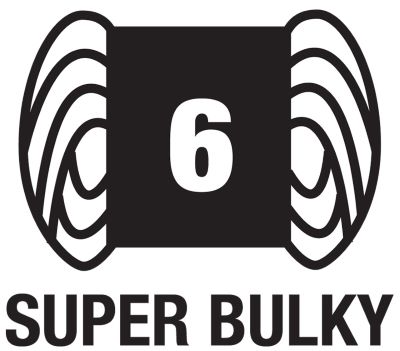
Also Known As
- Super Bulky – 6
- Roving
- Super Chunky
- 14-ply
- 16-ply
In the US, and other countries, super bulky weight yarn is also commonly called super chunky or roving. Let’s look at some other common terms too.
- Super Bulky – 6. This is how the CYC in the US defines the yarn weight thicker than bulky (5) yarn.
- Super Chunky. Chunky and bulky are often used interchangeably, so it’s not a surprise the same happens for super bulky. This term is more commonly used in the UK.
- Roving. This term means that the yarn is not twisted together into plies. It is a long strand of fibers bundled together, but not spun into yarn. It will give a nice, fuzzy texture.
The UK, Australia and New Zealand tend to refer to yarn weights by plies. The lower the ply count, the thinner the yarn. Although, don’t confuse this with how many plies the yarn is actually composed of. Ply count used to refer to the number of strands in the yarn, but modern processes have changed that. Now the term ply simply means the thickness of the yarn, when referring to yarn weights.
I looked at several sources to hopefully give the most accurate information, as I live in the US and don’t use this notation for yarn weights. This is what I found.
- 14-ply. It appears that 14-ply is a common term used in Australia that means the equivalent to super bulky weight yarn.
- 16-ply. New Zealand calls super bulky weight yarn 16-ply.
If you live in one of the areas that uses ply to determine yarn weight, please let me know if I should update this section!
Important Properties of Super Bulky Weight Yarn
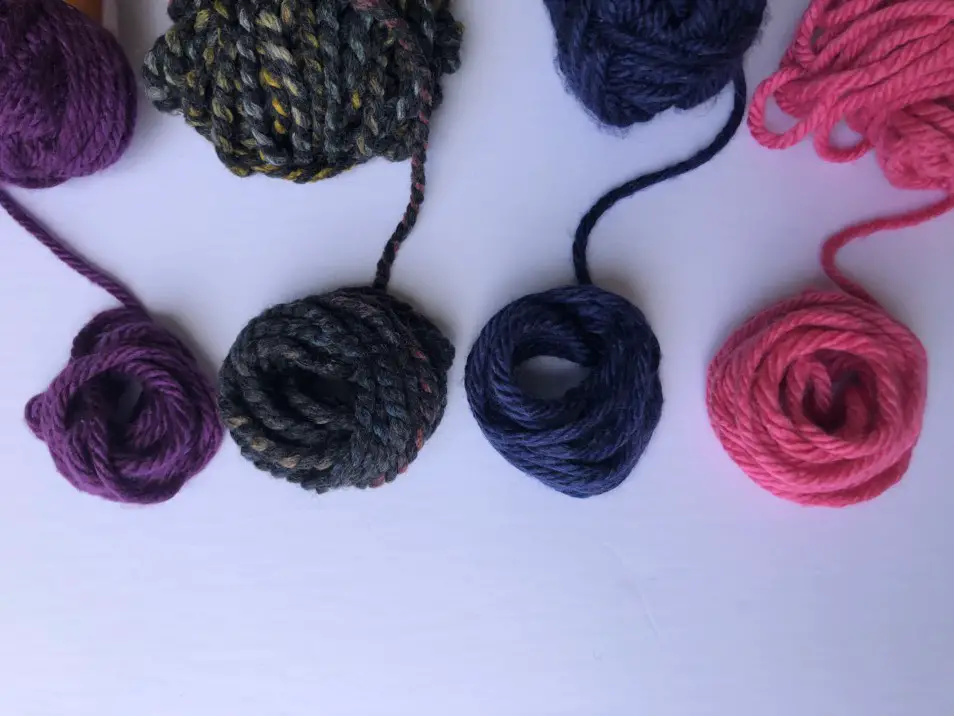
Super bulky weight yarn has several important properties that affect every purchaser of yarn. First there is fiber content. It is important to know what fibers the yarn is made from so you know how to treat it for your projects. Next, the yardage is important because that affects the project size. Finally, the price of the yarn is an important property that affects whether or nor you buy it.
Throughout these next sections, I dive deeper into each property of super bulky weight yarn. In order to do so, I conducted my own research. I looked at five major yarn companies so I could understand more about industry behaviors regarding yarn weights. I hope you find it interesting!
Common Fiber Content
I like to break fiber content into three categories: natural fibers, synthetic fibers, and blends of natural and synthetic fibers. According to my research, 8% of super bulky weight yarn is made from natural fibers and 63% is made from synthetic fibers. The other 29% is a blend of natural and synthetic fibers.
This surprises me a little because I thought there would be more super bulky yarn that was 100% natural fibers. But then again, it makes sense for much of the fiber content to contain synthetic. Synthetic is, afterall, easier to care for.
I have summarized the common fibers below. I didn’t add the blends though because that can vary.
Natural Fibers
- Wool
- Alpaca
- Silk
- Cotton
- Camel
- Cashmere
- Merino
Synthetic Fibers
- Polyamide
- Nylon
- Acrylic
- Polyester
- Viscose
Yardage Estimation
When it comes to yardage, unfortunately there is no set standard for the amount of yards per ounce/gram. That is up to the yarn manufacturer. But I was curious, just as I am sure you are, how many yards I can expect on average for super bulky weight yarn. This is super important when planning for a pattern.
As I stated before, I looked at 5 major yarn companies in the US. The following is based on my findings. For super bulky weight yarn, you can expect 110 yards per skein on average. The lowest amount of yardage I came across was 5 yards and the highest was 437 yards.
Average Price
Price is also an important aspect to keep in mind when you are choosing and comparing yarn. I found that you can expect to pay on average $8.48 per skein of super bulky weight yarn. Of course, that also means you could pay much more or much less depending on where you shop.
Where to Find Super Bulky Weight Yarn
Super bulky weight yarn can be found in a few places. Most chain craft stores carry some, but not a lot of super bulky weight yarn in stores. Lion Brand has a few lines of super bulky yarn. A few other blanket yarn brands also have super bulky yarn.
If you have a locally owned yarn shop in your area, you might have a bigger selection of super bulky weight yarn to choose from. I, however, don’t have that luxury, but wish I did.
Finally, you can always buy super bulky weight yarn online. There are many yarn retailers that have super chunky yarns for sale. The only drawbacks are that you must wait for its arrival (so hard!) and you can’t feel the yarn before purchasing.
Types of Projects Best for Super Bulky Weight Yarn
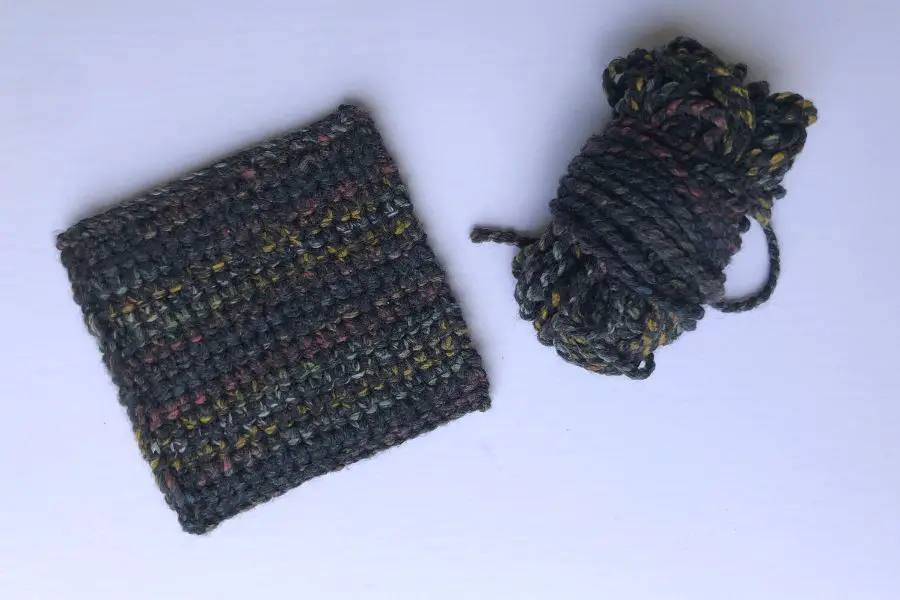
Super bulky weight yarn will produce a thick fabric that is very warm.
Projects will work up fast and won’t use up a ton of yarn. Super bulky yarn can make beautiful items, but I would not consider it my go to for everything. It has its place.
Ravelry has 43,049 patterns (at the time of this post) that uses super bulky yarn. There are many things you can make with it, so you will no doubt find a project that peaks your interest.
Popular items to knit or crochet with super bulky weight yarn include blankets, chunky accessories such as hats, scarves and cowls, and many home decor projects.
Accessories
- Hats (super popular!)
- Scarves
- Slipper Socks
- Cowls
- Headbands
- Mittens
Home Decor
- Blankets
- Wall Hangings
- Stuffed Animals
- Baskets
Garments
- Sweaters
- Ponchos
- Vests
Super Bulky Weight Yarn Recommendations + Tips
I’ve tried many different yarns, but these are a few of my recommendations of bulky weight yarn.
- Lion Brand Hometown USA – great for hats
- Lion Brand Wool-Ease Thick & Quick – great go-to chunky yarn always
- Bernat Blanket Big Ball Yarn
Tips:
- Don’t use straight needles. The yarn is super thick, so it will be very heavy. Using circular needles will make it easier on your hands.
- Have a loose tension. You don’t want to fight the yarn the whole time. Your hands and wrists will not be able to keep up. Hold the yarn loosely for the best results. Besides, you want your stitches to flow and have room to move. If you have too much tension, the fabric will just be thick and stiff, not ideal for blankets or garments.
Up Next
That concludes Super Bulky Weight yarn (6). The next post covers Jumbo yarn (2), which is the next size up of yarn. You can find it here.
The pictures listed at the top of the post are available in pattern form free through Ravelry. I do not claim these photos as my own, they are merely for illustration purposes. Click the links here to learn more about the patterns: Churchmouse Yarns and Teas and Crochet Dreamz.


